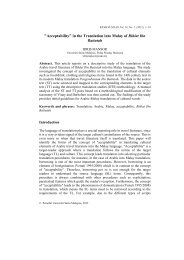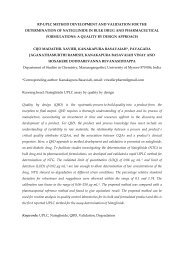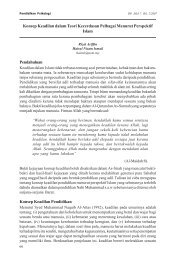Isolation, Identification and Molecular Characterization of Rare - USM
Isolation, Identification and Molecular Characterization of Rare - USM
Isolation, Identification and Molecular Characterization of Rare - USM
Create successful ePaper yourself
Turn your PDF publications into a flip-book with our unique Google optimized e-Paper software.
Malaysian Journal <strong>of</strong> Microbiology, Vol 8(2) 2012, pp. 83-91<br />
<strong>Isolation</strong>, <strong>Identification</strong> <strong>and</strong> <strong>Molecular</strong> <strong>Characterization</strong> <strong>of</strong> <strong>Rare</strong> Actinomycetes from<br />
Mangrove Ecosystem <strong>of</strong> Nizampatnam<br />
Usha Kiranmayi Mangamuri 1 , Vijayalakshmi Muvva 1* , Sudhakar Poda 2 , Sreenivasulu Kamma 2<br />
1 Department <strong>of</strong> Botany <strong>and</strong> Microbiology, Acharya Nagarjuna University Guntur -522510, Andhra Pradesh, India<br />
2 Department <strong>of</strong> Biotechnology, Acharya Nagarjuna University Guntur -522510, Andhra Pradesh, India.<br />
E-mail: pr<strong>of</strong>mvl@gmail.com<br />
ABSTRACT<br />
Received 3 August 2011; Received in revised form 10 January 2012; Accepted 23 January 2012<br />
Aims: Isolate <strong>and</strong> characterize the antimicrobial actinomycetes from sediments <strong>of</strong> Mangrove ecosystems <strong>of</strong><br />
Nizampatnam located in the south coastal region <strong>of</strong> Andhra Pradesh, India.<br />
Methodology <strong>and</strong> Results: The Mangrove soil samples were collected, pre-treated <strong>and</strong> plated on asparagine-glucose<br />
agar medium. <strong>Identification</strong> <strong>of</strong> the strain was carried out by employing the polyphasic taxonomical studies including the<br />
16S rRNA sequence based analysis. Phylogenetic tree was constructed using the <strong>Molecular</strong> Evolutionary Genetic<br />
Analysis (MEGA) version 5. The potent bioactive metabolite strain was isolated <strong>and</strong> designated as VUK-10. Further<br />
polyphasic studies revealed that the Isolate VUK-10 belongs to the genera Pseudonocardia. Phylogenetic analysis <strong>of</strong><br />
16S rRNA sequencing studies revealed that the strain is closely related to Pseudonocardia endophytica <strong>and</strong> the<br />
bioactive metabolites produced by the isolate inhibited Gram positive, Gram negative <strong>and</strong> Fungi.<br />
Conclusion, significance <strong>and</strong> impact <strong>of</strong> study: The isolation, characterization <strong>of</strong> the rare actinomycetes from the<br />
mangrove ecosystem will be useful for the discovery <strong>of</strong> the novel bioactive metabolites that are effective against wide<br />
range <strong>of</strong> pathogens.<br />
Keywords: Pseudonocardia, Mangrove ecosystem, Pre-treatment, Bioactive metabolites, Polyphasic Taxonomy.<br />
INTRODUCTION<br />
Mangroves are the coastal wet l<strong>and</strong> forests mainly found<br />
in the intertidal zone <strong>of</strong> estuaries, back waters, deltas,<br />
creeks, lagoons, marshes <strong>and</strong> also mud flats <strong>of</strong> the<br />
tropical <strong>and</strong> subtropical latitudes (Sahoo et al., 2009). The<br />
ecosystems where the mangrove plants grow are termed<br />
as “Mangrove Ecosystem” which occupies millions <strong>of</strong><br />
hectors across the world coastal areas (Spalding et al.,<br />
1997; Alongi, 2002). Mangrove marine ecosystems are<br />
largely uncaged source for screening <strong>and</strong> isolation <strong>of</strong> new<br />
microbes with rich potential to produce the important<br />
active secondary bioactive metabolites. The environment<br />
<strong>of</strong> the mangrove ecosystem is saline, <strong>and</strong> highly rich in an<br />
organic matter because <strong>of</strong> its various microbial enzymatic<br />
<strong>and</strong> metabolic activities (Kizhekkedathu <strong>and</strong><br />
Parukuttyamma, 2005). The natural products remain to be<br />
the most important source <strong>of</strong> antibiotics (Bull <strong>and</strong> Starch,<br />
2007). Marine derived compounds are more efficient in<br />
action against the pathogens that are resistance to the<br />
existing antibiotics (Donia <strong>and</strong> Hamman, 2003).<br />
The risk undermining the health care system is because <strong>of</strong><br />
the relentless <strong>and</strong> rapid spread <strong>of</strong> the multiple antibiotic<br />
resistant pathogens causing life threatening infection<br />
(Talbot et al., 2006) <strong>and</strong> so the dem<strong>and</strong> for new antibiotics<br />
continues to grow. Although, considerable progress has<br />
been made within the fields <strong>of</strong> chemical synthesis <strong>and</strong><br />
engineered biosynthesis <strong>of</strong> antibacterial compounds,<br />
*Corresponding author<br />
nature remains the richest <strong>and</strong> the most versatile source<br />
for new antibiotics (Baskaran et al., 2011). Since<br />
actinomycetes have an important proven capacity to<br />
produce novel antibiotics (Bentley et al., 2002), the<br />
practice in screening such organisms for the new<br />
bioactive compounds is continued (Bérdy, 2005).<br />
However, difficulty to discover the commercially potent<br />
secondary metabolites from well-known actinomycetes is<br />
becoming increasingly difficult due to the practice <strong>of</strong><br />
wasteful screening that is leading to rediscovery <strong>of</strong> the<br />
known bioactive compounds (Kui et al., 2009). This<br />
stringent condition emphasizes the need to screen <strong>and</strong><br />
isolate the undiscovered representatives <strong>of</strong> the<br />
unexplored actinomycetes taxa. It is a clear object that the<br />
mangrove ecosystem is a rich source <strong>of</strong> novel<br />
actinomycetes that have the capacity to produce<br />
interesting new bioactive compounds including antibiotics.<br />
Screening for the microbial species is an important aspect<br />
as there is a remarkable source for the production <strong>of</strong><br />
structurally diverse secondary metabolites that possess<br />
pharmaceutically relevant biological activities (Berdy,<br />
2005). It has long been an observed fact that the search<br />
for the new secondary metabolites from microorganisms<br />
in general has been confounded because different strains<br />
belonging to the same species are capable <strong>of</strong> producing<br />
different secondary metabolites (Waksman <strong>and</strong> Bugie,<br />
1943) but identical secondary metabolites are produced<br />
by taxonomically diverse strains (Larsen et al., 2005).<br />
83 ISSN (print): 1823-8262, ISSN (online): 2231-7538
Mal. J. Microbiol. Vol 8(2) 2012, pp. 83-91<br />
Challenges raised questions against using the traditional<br />
taxonomic methods to differentiate among closely related<br />
actinomycetes contribute to the former. Sequence based<br />
approaches can now be addressed towards these<br />
challenges that resolute the taxonomic <strong>and</strong> opportunities<br />
to extract the relationship between the groups <strong>of</strong> related<br />
strains <strong>and</strong> the secondary metabolites they produce. In<br />
addition, these methods are the tools to probe the<br />
evolutionary history <strong>of</strong> the metabolic pathways <strong>and</strong> thus<br />
infer the root <strong>and</strong> action <strong>of</strong> the lateral gene transfer (LGT)<br />
responsible for the unrelated organisms to produce similar<br />
compounds (Paul et al.In view <strong>of</strong> the above discussion,<br />
the present study is taken up to isolate, screen <strong>and</strong><br />
characterize the biologically diverse strains <strong>of</strong><br />
actinomycetes from the mangrove sediment samples for<br />
bioactive secondary metabolites. In the systematic<br />
screening programme, an actinomycetes strain VUK-10<br />
was isolated from a sediment sample taken from<br />
mangrove area on the south coast <strong>of</strong> India. Taxonomic<br />
characterization was carried out based on 16S rRNA<br />
sequence analysis in combination with morphological,<br />
physiological <strong>and</strong> biochemical data. The ability to produce<br />
antibacterial <strong>and</strong> antifungal compounds was also<br />
investigated.<br />
MATERIALS AND METHODS<br />
Sample Collection<br />
Sediment samples were collected from different areas <strong>of</strong><br />
the Nizampatnam mangrove ecosystem (Lat, 15° 54’0 N;<br />
Long 80° 40’0 E) situated along the south coast <strong>of</strong> Andhra<br />
Pradesh, India. The central portion <strong>of</strong> the 6-10 cm<br />
sediment sample was taken <strong>and</strong> transferred to a sterile<br />
bag <strong>and</strong> transported immediately to the laboratory.<br />
<strong>Isolation</strong><br />
The samples thus collected were air-dried at room<br />
temperature. Actinomycetes were isolated by suspending<br />
pre-treated soil sample at 55 °C for 15 min in a<br />
suspension fluid containing osmoprotectant (i.e. quarter<br />
strength ringer’s solution), serially diluted up to 10 -5 <strong>and</strong><br />
placed on asparagine–glucose agar medium (Smith,<br />
1943) supplemented with nalidixic acid (25 µg/mL) <strong>and</strong><br />
secnidazole (25 µg/mL) in order to retard the growth <strong>of</strong><br />
bacteria <strong>and</strong> fungi respectively. After incubation <strong>of</strong> the<br />
plates at room temperature for two weeks, typical<br />
actinomycetes colonies selected on morphological basis<br />
(Shirling <strong>and</strong> gottlieb, 1996) were picked out, purified <strong>and</strong><br />
preserved on medium at 4 °C (Williams <strong>and</strong> Cross, 1971).<br />
The isolated actinomycetes strains were then screened<br />
with regard to their potential to generate bioactive<br />
compounds (Atta et al., 2009).<br />
<strong>Identification</strong> by Polyphasic Taxonomy<br />
The potent actinomycete isolate was characterized by<br />
morphological, cultural, physiological, biochemical <strong>and</strong><br />
molecular methods. Morphological methods consist <strong>of</strong><br />
macroscopic <strong>and</strong> microscopic methods. The microscopic<br />
characterization was done by slide culture method<br />
(Williams <strong>and</strong> Cross, 1971). The mycelium structure,<br />
colour <strong>and</strong> arrangement <strong>of</strong> spores on the mycelium were<br />
observed through inverted microscope [400X, Olympus].<br />
The cultural characteristics <strong>of</strong> the strain were studied on<br />
various ISP <strong>and</strong> non-ISP media (Shirling <strong>and</strong> Gottlieb,<br />
1966). Melanin pigment production was determined by<br />
growth on tyrosine agar (ISP-7) medium (Pridham et al.,<br />
1957). Hydrolysis <strong>of</strong> starch <strong>and</strong> nitrate productions was<br />
carried out according to the method <strong>of</strong> (Gordon, 1966).<br />
H2S production was tested according to (Cowan, 1974).<br />
Liquefaction <strong>of</strong> gelatine was evaluated by the method <strong>of</strong><br />
(Waksman, 1961). Catalase test was evaluated by the<br />
method <strong>of</strong> (Jones, 1949). Carbohydrate utilization was<br />
determined by growth on carbon utilization medium (ISP-<br />
9) (Pridham <strong>and</strong> Gottlieb, 1948) supplemented with 1 %<br />
carbon source. The cultural characteristics <strong>of</strong> the strain<br />
were studied on different ISP <strong>and</strong> non ISP media.<br />
Physiological characterization such as the effect <strong>of</strong> pH (5-<br />
9), temperature (20-60 °C) <strong>and</strong> salinity were analysed. In<br />
addition, the susceptibility <strong>of</strong> the strain to different<br />
antibiotics was determined by paper disc method<br />
(Cappuccino <strong>and</strong> Sherman, 2004).<br />
Actinomycete strains were grown in 10 mL tryptone yeast<br />
extract broth (ISP 1) (Shirling <strong>and</strong> Gottlieb, 1966) with<br />
agitation at 30 °C for 18–24 h. Cells were harvested by<br />
centrifugation (7500 g for 2 min), washed once with 500<br />
mL <strong>of</strong> 10 mM Tris-HCl/ 1 mM EDTA (TE) buffer (pH 7) <strong>and</strong><br />
resuspended in 500 mL TE buffer (pH 7). The samples<br />
were heated in boiling water for 10 min, allowed to cool for<br />
5 min <strong>and</strong> centrifuged (7500 g for 3 min). The supernatant<br />
(300 mL) was transferred to a clean tube <strong>and</strong> stored at 4<br />
°C. If melanin or other pigments were produced during<br />
growth in ISP 1, cultures were grown in Middle brook 7H9<br />
broth, as these pigments interfere with the PCR<br />
(Polymerase chain reaction).<br />
<strong>Molecular</strong> <strong>Identification</strong><br />
The genomic DNA (Deoxyribo nucleic acid) used for the<br />
PCR was prepared from the single colonies grown on the<br />
Yeast extract malt extract dextrose agar (ISP-2) medium<br />
for 3 days. The total genomic DNA extracted from the<br />
potent strain (VUK-10) was isolated employing the DNA<br />
purification Kit (Pure Fast® Bacterial Genomic DNA<br />
purification kit, Helini Bio molecules, India) according to<br />
the manufacturer protocol. The 16S rRNA gene fragment<br />
was amplified using Universal Primers. (Actino specific<br />
forward Primer -5'-GCCTAACACATGCAAGTCGA-3' <strong>and</strong><br />
Actino Specific Reverse primer - 5'-<br />
CGTATTACCGCGGCTGCTGG-5') (Nilsson <strong>and</strong> Strom,<br />
2002). Conditions <strong>of</strong> the PCR were st<strong>and</strong>ardized with<br />
initial denaturation at 94 °C for 3 min followed by 30<br />
cycles <strong>of</strong> amplification (Denaturation at 94 °C for 60 sec,<br />
annealing temperature is 55 °C for 60 sec <strong>and</strong> extension<br />
at 72 °C for 60 sec) <strong>and</strong> an addition <strong>of</strong> 5 min at 72 °C as<br />
final extension. The amplification reactions were carried<br />
with a total volume <strong>of</strong> 50 µL in a Gradient PCR<br />
84 ISSN (print): 1823-8262, ISSN (online): 2231-7538
Mal. J. Microbiol. Vol 8(2) 2012, pp. 83-91<br />
(Eppendorf, Germany). Each reaction mixture contained 1<br />
µL <strong>of</strong> DNA, 1 µL <strong>of</strong> 10 pmol forward 16S Actino specific<br />
primer (5´-AAATGGAGGAAGGTGGGGAT-`3); 1 µL <strong>of</strong> 10<br />
pmol reverse 16S Actino specific primer (5´-<br />
AGGAGGTGATCCAACCGCA-`3); 25 µL <strong>of</strong> Master Mix<br />
<strong>and</strong> 22 µL <strong>of</strong> molecular grade nuclease free water.<br />
The separation was carried out at 90 Volts for 40 min in<br />
TAE buffer with 5 µL <strong>of</strong> Ethidium bromide (Messner et al.,<br />
1994). PCR product was analysed using 1 % agarose<br />
gel <strong>and</strong> the fragment was purified (Helini Pure Fast PCR<br />
clean up kit, Helini Bio molecules, India) according to the<br />
manufacturer instructions. The b<strong>and</strong>s were analyzed<br />
under UV light <strong>and</strong> documented using Gel Doc. The direct<br />
sequencing <strong>of</strong> PCR products was performed by dideoxy<br />
chain termination method using 3100-Avant Genetic<br />
Analyzer (Applied Bio systems, USA). The obtained<br />
sequences were analyzed for homology using BLASTN<br />
(Entrez Nucleotide database).<br />
Nucleotide Sequence Accession Numbers<br />
The 16S rRNA gene (rDNA) sequences <strong>of</strong> the strain VUK<br />
-10 are registered in the GenBank database with the<br />
accession number.<br />
Extraction <strong>of</strong> Antimicrobial Metabolites<br />
The inoculum was prepared by suspending spores from<br />
one week old culture (Yeast extract malt extract dextrose<br />
agar) in 10 mL <strong>of</strong> sterile saline. 5 mL <strong>of</strong> the homogenous<br />
spore suspension was used to inoculate 50 mL <strong>of</strong><br />
asparagines-glucose broth (seed medium) in a 250 mL<br />
Erlenmeyer flask, <strong>and</strong> the culture was incubated at 30 °C<br />
for 48 h on a rotator shaker at 120 rpm. Seed culture at<br />
the rate <strong>of</strong> 10 % was transferred into 500 mL <strong>of</strong> starch -<br />
casein broth (Fermentation medium). The fermentation<br />
was carried out at 28±2 °C for 96 h under agitation at 120<br />
rpm. Antimicrobial compound was purified from the filtrate<br />
by solvent extraction method. Ethyl acetate was added to<br />
the filtrate in the ratio <strong>of</strong> 1:1 (V/V) <strong>and</strong> shaken vigorously<br />
for 1 h for complete extraction. The ethyl acetate phase<br />
that contains bioactive metabolites was separated from<br />
the aqueous phase. It was evaporated to dryness in water<br />
bath <strong>and</strong> residue obtained was used to determine<br />
antimicrobial activity by agar well diffusion method<br />
(Cappuccino <strong>and</strong> Sherman, 2004) <strong>and</strong> effectiveness was<br />
measured by zone <strong>of</strong> inhibition.<br />
RESULTS AND DISCUSSION<br />
The present study was designed to investigate the<br />
mangrove ecosystem <strong>of</strong> Nizampatnam for novel<br />
actinomycetes <strong>and</strong> their antimicrobial properties. During<br />
our continuous search for novel antimicrobial metabolites<br />
<strong>of</strong> Nizampatnam mangrove region led to the isolation <strong>of</strong><br />
morphologically distinct actinomycetes isolate VUK-10 on<br />
asparagine glucose agar media by employing soil dilution<br />
plate technique. The strain VUK -10 exhibited typical<br />
morphological characteristics <strong>of</strong> the genus<br />
Pseudonocardia (Warwick et al., 1994; Huang et al.,<br />
2002). Morphological <strong>and</strong> micro morphological<br />
observation <strong>of</strong> the strain revealed that aerial <strong>and</strong><br />
vegetative hyphae were abundant, well developed <strong>and</strong><br />
fragmented with rod shaped smooth surfaced spores.<br />
Soluble pigment production by the strain was not found on<br />
the culture media tested except melanin pigmentation on<br />
tyrosine (ISP-7) agar media.<br />
Cultural Characteristics<br />
The cultural characteristics <strong>of</strong> the strain are represented in<br />
Table 1. The strain VUK- 10 exhibited good growth on<br />
tryptone-yeast extract (ISP-1) agar, yeast extract-malt<br />
extract-dextrose (ISP-2) agar, oat-meal (ISP-3) agar,<br />
glycerol-asparagine (ISP-5) agar, czapek-dox agar <strong>and</strong><br />
maltose-tryptone agar. The growth was moderate on<br />
starch-inorganic salts (ISP-4) agar, tyrosine agar (ISP-7)<br />
<strong>and</strong> starch casein agar while it was poor on nutrient agar.<br />
Creamy white aerial mycelium was found on ISP-1, ISP -<br />
2, ISP-7, maltose tryptone <strong>and</strong> starch casein agar where<br />
as the aerial mycelium was cream colour in ISP-4, ISP-5<br />
<strong>and</strong> creamy orange in czapek-dox agar. No aerial<br />
mycelium was formed on nutrient agar medium. The<br />
substrate mycelium ranges from brownish orange (on ISP-<br />
1 <strong>and</strong> ISP-2) to brown (ISP-3, ISP-4, ISP-5 <strong>and</strong> ISP-7) or<br />
light orange (czapek-dox agar, maltose tryptone agar <strong>and</strong><br />
nutrient agar). Siva Kumar (2001) reported that the<br />
cultural characteristics could be used as markers by which<br />
an individual strain can be recognized.<br />
Physiological Characteristics<br />
The physiological tests are indispensable tools for<br />
classification <strong>and</strong> identification <strong>of</strong> actinomycetes <strong>and</strong><br />
influencing the growth rate <strong>of</strong> actinomycetes (Kampfer et<br />
al., 1991; Hasegawa et al., 1978; Kim et al., 1999 <strong>and</strong><br />
Shimizu et al., 2000). Growth <strong>of</strong> the strain VUK-10<br />
occurred in the pH range <strong>of</strong> 6-9 with optimum growth at<br />
pH 7. The temperature range for growth was 20-45 °C<br />
with the optimum temperature being 35 °C. The strain<br />
exhibited salt tolerance up to 10 % with optimum growth at<br />
3 % NaCl; hence, the strain could be placed in<br />
intermediate salt tolerance group according to Tresner et<br />
al. (1968).<br />
Biochemical <strong>Characterization</strong><br />
VUK-10 exhibited positive response to catalase<br />
production <strong>and</strong> citrate utilization but negative for urease,<br />
hydrogen sulphide production, nitrate reduction, starch<br />
hydrolysis, gelatine liquefaction, indole, methyl red <strong>and</strong><br />
vogues-proskauer tests. The details <strong>of</strong> morphological,<br />
physiological <strong>and</strong> biochemical characteristics <strong>of</strong> the isolate<br />
are given in (Table 2).<br />
Utilization <strong>of</strong> carbon sources by the strains could be used<br />
as an aid for species determination (Pridham <strong>and</strong> Gottlieb,<br />
1948). The strain VUK-10 efficiently utilized the carbon<br />
sources such as D-glucose, lactose, maltose, sucrose,<br />
85 ISSN (print): 1823-8262, ISSN (online): 2231-7538
Mal. J. Microbiol. Vol 8(2) 2012, pp. 83-91<br />
galactose, fructose, starch but not utilized xylose,<br />
arabinose <strong>and</strong> mannitol (Table 3). Good fellow <strong>and</strong><br />
Orchard (1974) reported that the antibiotic sensitivity <strong>of</strong><br />
some nocardi<strong>of</strong>orm bacteria as one <strong>of</strong> the valuable criteria<br />
for their taxonomic differentiation. Antibiotic susceptibility<br />
testing showed that the isolate was susceptible to<br />
streptomycin, gentamicin, rifampicin, chloramphenicol <strong>and</strong><br />
oxytetracycline <strong>and</strong> resistance to nalidixic, acid <strong>and</strong><br />
penicillin (Table 4).<br />
Table 1: Cultural Characteristics <strong>of</strong> Pseudonocardia sp. VUK- 10<br />
S No Name <strong>of</strong> the Medium Pseudonocardia sp.<br />
VUK-10<br />
1 Tryptone yeast-extract agar (ISP-1)<br />
Growth<br />
Aerial mycelium<br />
Substrate mycelium<br />
Pigmentation<br />
2 Yeast extract malt extract dextrose agar (ISP-2)<br />
Growth<br />
Aerial mycelium<br />
Substrate mycelium<br />
Pigmentation<br />
3 Oat-meal agar (ISP-3)<br />
Growth<br />
Aerial mycelium<br />
Substrate mycelium<br />
Pigmentation<br />
4 Oat-meal agar (ISP-3)<br />
Growth<br />
Aerial mycelium<br />
Substrate mycelium<br />
Pigmentation<br />
5 Glycerol asparagine agar (ISP-5)<br />
Growth<br />
Aerial mycelium<br />
Substrate mycelium<br />
Pigmentation<br />
6 Tyrosine agar( ISP-7)<br />
Growth<br />
Aerial mycelium<br />
Substrate mycelium<br />
Pigmentation<br />
7 Starch-casein agar<br />
Growth<br />
Aerial mycelium<br />
Substrate mycelium<br />
Pigmentation<br />
8 Czapek-dox agar<br />
Growth<br />
Aerial mycelium<br />
Substrate mycelium<br />
Pigmentation<br />
9 Maltose tryptone agar<br />
Growth<br />
Aerial mycelium<br />
Substrate mycelium<br />
Pigmentation<br />
10 Nutrient agar<br />
Growth<br />
Aerial mycelium<br />
Substrate mycelium<br />
Pigmentation<br />
Good<br />
Creamy white<br />
Brownish orange<br />
Nil<br />
Good<br />
Creamy white<br />
Brownish orange<br />
86 ISSN (print): 1823-8262, ISSN (online): 2231-7538<br />
Nil<br />
Good<br />
White<br />
Brown<br />
Nil<br />
Good<br />
White<br />
Brown<br />
Nil<br />
Good<br />
Cream<br />
Brown<br />
Nil<br />
Moderate<br />
Creamy white<br />
Brown<br />
Melanin<br />
Moderate<br />
Creamy white<br />
Light brown<br />
Nil<br />
Good<br />
Creamy orange<br />
Light orange<br />
Nil<br />
Good<br />
Creamy white<br />
Light orange<br />
Nil<br />
Good<br />
Creamy white<br />
Orange<br />
Nil
Mal. J. Microbiol. Vol 8(2) 2012, pp. 83-91<br />
Table 2: Differential characteristics <strong>of</strong> strain VUK-10 <strong>and</strong> type strains <strong>of</strong> closely related Pseudonocardia species. Strain<br />
VUK-10 (Data from the study). P. endophytica YIM 56035 (Data obtained from study Hua et al., 2009). P.kongjuensis<br />
DSM 44525 (Data obtained from Hua et al., 2009). P.ammonioxydans H9 (data obtained from Liu et al., 2006). (+) -<br />
Positive or Present; (W) weakly positive; (-) – Negative; ND- No data available<br />
CHARACTER RESPONSE<br />
Morphological Characters<br />
S No Characteristics under VUK-10 P. endophytica P. kongjuensis P. ammonioxydans<br />
study<br />
YIM 56035 DSM 44525 H9<br />
1 Sporophore<br />
Fragmentation Fragmentation Fragmentation Fragmentation<br />
morphology<br />
2 Color <strong>of</strong> aerial<br />
Creamy white White White White<br />
mycelium<br />
3 Color <strong>of</strong> substrate Brownish Yellowish-brown Yellowish- Brown<br />
mycelium<br />
orange<br />
Physiological Characters<br />
brown<br />
4 Gram reaction +, aerobic +, aerobic +, aerobic +, aerobic<br />
5 Acid-fast reaction<br />
6 Production <strong>of</strong> melanin<br />
pigment<br />
7 Production <strong>of</strong> Diffusible<br />
pigment<br />
8 Range <strong>of</strong> temperature<br />
for growth<br />
9 Optimum temperature<br />
for growth<br />
10 Range <strong>of</strong> pH for growth<br />
11 Optimum ph for growth<br />
12 NaCl Tolerance<br />
13 Optimum NaCl<br />
Concentration<br />
14 Catalase production<br />
15 Urease production<br />
16 Hydrogen sulfide<br />
production<br />
17 Nitrate reduction<br />
18 Starch hydrolysis<br />
19 Gelatin liquefaction<br />
20 Methyl red test<br />
21 Vogues-proskauer test<br />
22 Indole production<br />
23 Citrate utilization<br />
24 Casein hydrolysis<br />
<strong>Molecular</strong> <strong>Characterization</strong><br />
Analysis <strong>of</strong> the 16s rDNA gene sequence <strong>of</strong> the strain<br />
vuk-10<br />
The 16S rDNA sequence data supported the assignment<br />
<strong>of</strong> this isolate VUK-10 to the genus Pseudonocardia <strong>and</strong><br />
species endophytica (Pseudonocardia endophytica). The<br />
800 bp partial 16S rDNA sequence <strong>of</strong> the strain VUK10<br />
was obtained <strong>and</strong> submitted to the GenBank database<br />
under an accession number JN087501. The partial<br />
sequence was aligned <strong>and</strong> compared with all the 16S<br />
rRNA gene sequence available in the GenBank database<br />
by using the multisequence advanced BLAST comparison<br />
- ND - ND<br />
+ - - -<br />
- - - -<br />
25-50 ºC 15-37 ºC 4-37 ºC 10-40 ºC<br />
30 ºC 28 ºC ND ND<br />
5-9 6-8 ND ND<br />
7 ND ND ND<br />
10 % 5 % 7 % 8 %<br />
3 % 1 % ND 3.5 %<br />
+<br />
Biochemical Characters<br />
+ + +<br />
- - + +<br />
- - + +<br />
- - - +<br />
- - - W<br />
- - - W<br />
- ND ND ND<br />
- ND ND ND<br />
- ND ND ND<br />
+ ND ND ND<br />
- - + +<br />
tool that is available in the website <strong>of</strong> National Centre for<br />
Biotechnology Information. The highest 16S rRNA<br />
sequence similarity value <strong>of</strong> 98% was obtained for the<br />
Pseudonocardia endophytica 16s rRNA (GenBank<br />
accession no: DQ887489) (Frederic et al., 1999). The<br />
phylogenetic analysis <strong>of</strong> the 16S rRNA gene sequence<br />
was aligned using the CLUSTAL W programme from the<br />
MEGA 5 Version. Phylogenetic tree was constructed<br />
using <strong>Molecular</strong> Evolutionary Genetics Analysis (MEGA)<br />
s<strong>of</strong>tware Version 5 using Maximum parsimony method<br />
(Saitou <strong>and</strong> Nei, 1987; Takahashi <strong>and</strong> Nei, 2000; Tamura<br />
et al., 2007, 2011). The topologies <strong>of</strong> the constructed tree<br />
were evaluated by bootstrap analysis with 1000<br />
resamplings by Maximum parsimony tool. Sequence<br />
comparison <strong>of</strong> the strain VUK-10 with the corresponding<br />
87 ISSN (print): 1823-8262, ISSN (online): 2231-7538
Mal. J. Microbiol. Vol 8(2) 2012, pp. 83-91<br />
Figure 1: Maximum Parsimony tree based on partial 16S rRNA gene sequence showing relationship between<br />
Pseudonocardia isolate VUK-10 <strong>and</strong> related members <strong>of</strong> the genus Pseudonocardia. The numbers at the nodes indicate<br />
the level <strong>of</strong> bootstrap support based on Maximum parsimony analysis <strong>of</strong> 1000 resampled datasets; Only values above<br />
50% are given.<br />
88 ISSN (print): 1823-8262, ISSN (online): 2231-7538
Mal. J. Microbiol. Vol 8(2) 2012, pp. 83-91<br />
Table 3: Utilization <strong>of</strong> the carbon sources. Excellent<br />
(+++), Moderate (++), Poor (-)<br />
Utilization <strong>of</strong> Carbon Sources<br />
1 Lactose ++<br />
2 Maltose ++<br />
3 Xylose -<br />
4 Sucrose ++<br />
5 Arabinose -<br />
6 D-Glucose +++<br />
7 Galactose ++<br />
8 Fructose ++<br />
9 Starch +<br />
10 Mannitol -<br />
Table 4: Antibiotic susceptibility testing <strong>of</strong> VUK-10<br />
Susceptibility to Antibiotics: (µg/disc)<br />
1 Nalidixic acid (30)<br />
2 Streptomycin (10)<br />
3 Penicillin (10)<br />
4 Chloramphenicol (30)<br />
5 Rifampicin S<br />
6 Oxy tetracyclin S<br />
Table 5: Antimicrobial Activity <strong>of</strong> Pseudonocardia sp.<br />
VUK-10<br />
S.N Test organism Diameter <strong>of</strong> Clear<br />
o<br />
zone<br />
1 Staphylococcus aureus<br />
MTCC 3160<br />
13<br />
2 Streptococcus mutans<br />
MTCC 497<br />
15<br />
3 Bacillus subtilis ATCC<br />
6633<br />
12<br />
4 E.coli ATCC 35218 11<br />
5 Enterococcus faecalis<br />
MTCC 439<br />
13<br />
6 Pseudomonas<br />
aeruginosa ATCC 9027<br />
15<br />
7 C<strong>and</strong>ida albicans ATCC<br />
10231<br />
10<br />
8 Fusarium oxysporum<br />
MTCC 3075<br />
7<br />
9 Aspergillus niger 9<br />
sequences <strong>of</strong> the close representative strains <strong>of</strong><br />
Pseudonocardia from the GenBank database showed that<br />
this strain formed a close distinct phyletic line with clade<br />
encompassed by Pseudonocardia endophytica,<br />
Pseudonocardia ammonioxdans <strong>and</strong> Pseudonocardia<br />
kongjuensis (fig. 1). Differential characteristics <strong>of</strong> strain<br />
VUK-10 <strong>and</strong> type strains <strong>of</strong> closely related<br />
Pseudonocardia sp. are represented in Table 2.<br />
R<br />
S<br />
R<br />
S<br />
Based on the morphological, cultural, physiological,<br />
biochemical <strong>and</strong> molecular characteristics the strain has<br />
been included under the genus Pseudonocardia <strong>and</strong><br />
deposited at NCBI genbank with an accession number<br />
JN087501.<br />
Antimicrobial spectrum <strong>of</strong> Pseudonocardia species VUK-<br />
10 is represented in Table 5. The strain inhibited growth<br />
<strong>of</strong> Gram positive <strong>and</strong> Gram negative bacteria, yeast <strong>and</strong><br />
fungi suggesting a broad spectrum nature <strong>of</strong> the active<br />
compound.<br />
A perusal <strong>of</strong> literature indicates the bioactive metabolite<br />
pr<strong>of</strong>ile <strong>of</strong> Pseudonocardia sp. includes antibacterial,<br />
antifungal, enzyme inhibitors, neuro protective <strong>and</strong> anti-<br />
Helicobacter pylori compounds. Rajendra et al. (2003)<br />
isolated a new phenazine derivative, phenazostatin D<br />
from Pseudonocardia sp.B6273, acts as a<br />
neuroprotective. Omura et al. (1979) reported<br />
antimicrobial activity <strong>of</strong> the antibiotics azureomycins A <strong>and</strong><br />
B from Pseudonocardia azurea sp. Dekkar et al. (1998)<br />
extracted new quinolone compounds from<br />
Pseudonocardia sp. with selective <strong>and</strong> potent anti-<br />
Helicobacter pylori activity.<br />
CONCLUSION<br />
The present study is mainly involved in the isolation <strong>and</strong><br />
identification <strong>of</strong> actinomycetes based on the cultural,<br />
morphological physiological, biochemical <strong>and</strong> molecular<br />
characteristics. Further studies on optimization,<br />
purification <strong>and</strong> elucidation <strong>of</strong> chemical structure <strong>of</strong> active<br />
compound are currently in progress. It is expected that the<br />
current attempt for the isolation <strong>and</strong> characterization <strong>of</strong><br />
actinobacteria from Nizampatnam mangrove ecosystem<br />
will be useful for the identification <strong>of</strong> novel antibiotics<br />
effective against various pathogens.<br />
ACKNOWLEDGEMENTS<br />
Authors (MUK <strong>and</strong> MVL) are thankful to the council <strong>of</strong><br />
scientific <strong>and</strong> industrial research for providing financial<br />
support to carry out this study.<br />
REFERENCES<br />
Alongi, D. M. (2002). Present state <strong>and</strong> future <strong>of</strong> the<br />
world’s mangrove forests. Environmental Conservation<br />
29, 331-349.<br />
Atta, H. M., Dabour, S. M. <strong>and</strong> Desoket, S. G. (2009).<br />
Saprosomycin antibiotic production by Streptomyces<br />
sp AZ-NIOFD1: Taxonomy, Frementation, Purification<br />
<strong>and</strong> Biological Activities, American Eurasian, Journal<br />
<strong>of</strong> Agriculture <strong>and</strong> Environmental Sciences 5, 368-<br />
377.<br />
Baltz, R. H. (2008). Renaissance in antibacterial<br />
discovery from actinomycetes. Current Opinion in<br />
Pharmacology 8, 1-7.<br />
Baskaran, R. Vijayakumar, R. <strong>and</strong> Mohan, P. M. (2011).<br />
89 ISSN (print): 1823-8262, ISSN (online): 2231-7538
Mal. J. Microbiol. Vol 8(2) 2012, pp. 83-91<br />
Enrichment method for the isolation <strong>of</strong> bioactive<br />
actinomycetes from mangrove sediments <strong>of</strong> Andaman<br />
Isl<strong>and</strong>s, India. Malaysian Journal <strong>of</strong> Microbiology 7,<br />
26-32.<br />
Behal, V. (2003). Alternative sources <strong>of</strong> biologically active<br />
substances. Folia Microbiologica 48, 563 – 571.<br />
Bentley, S. D., Chater, K. F., Cerdeno-Tarraga, A. M.,<br />
Challis, G. L., Thompson, N. R., James, K. D.,<br />
Complete genome sequence <strong>of</strong> the model<br />
actinomycete Streptomyces coelicolor A3(2). Nature<br />
417, 141-147.<br />
Harris, D. E., Quail, M. A., Kieser, H. <strong>and</strong> Harper, D.<br />
(2002). Complete genome sequence <strong>of</strong> the model<br />
actinomycete Streptomyces coelicolor A3(2). Nature<br />
417, 141-147.<br />
Bérdy, J. (2005). Bioactive microbial metabolites. The<br />
Journal <strong>of</strong> Antibiotics 58, 1–26.<br />
Bredholt, H., Fjaervik, E., Jhonsen, G. <strong>and</strong> Zotechev,<br />
S. B. (2008). Actinomycetes from sediments in the<br />
Trondhein Fjrod, Norway: Diversity <strong>and</strong> biological<br />
activity. Journal <strong>of</strong> Marine Drugs 6, 12-24.<br />
Bull, A. T. <strong>and</strong> Starch, J. E. M. (2007). Marine<br />
actinobacteria: new opportunities for natural product<br />
search <strong>and</strong> discovery. Trends. Microbiology 15, 491-<br />
499.<br />
Dekker, K. A., Inagaki, T., Gootz, T. D., Huang, L. H.,<br />
Kozima, Y., Kohlbrenner, W. E., Matsunaga, Y.,<br />
Mcguirk, P. R., Nomurae, E., Sakakibara, T.,<br />
Sakemi, S., Suzuki, Y., Yamauchi, Y. <strong>and</strong> Kojima,<br />
N. (1998). New quinolone compounds from<br />
Pseudonocardia sp. with selective <strong>and</strong> potent anti<br />
helicobacter pylori activity. Taxonomy <strong>of</strong> producing<br />
strain , fermentation, isolation, structural elucidation<br />
<strong>and</strong> biological activities. The Journal Antibiotics 51,<br />
145-152.<br />
Donia, M. <strong>and</strong> Humman, M. T. (2003). Marine natural<br />
products <strong>and</strong> their potential applications as an<br />
antiinfective agents. The Lancet Infectious Diseases 3,<br />
338 – 348.<br />
Fiedler, H. P., Bruntner, C., Bull, A. T., Ward, A. C.,<br />
Good Fellow, M ., Potterat, O ., Pudar, C. <strong>and</strong><br />
Mihm, G. (2005). Marine actinomycetes as a source <strong>of</strong><br />
novel secondary metabolites. Antonie van<br />
leeuwenhock 92, 173-199.<br />
Frederic, B., Claude, B., Thierry, C., Eric, G. <strong>and</strong><br />
Michel, D. (1999). <strong>Molecular</strong> <strong>Identification</strong> <strong>of</strong> a<br />
Nocardiopsis dassonvillei blood Isolate. Journal <strong>of</strong><br />
Clinical Microbiology 36, 3366-3368.<br />
Glen, P. E., Peter, R. B. <strong>and</strong> D. I. Kurtböke. (2008). The<br />
Occurrence <strong>of</strong> Bioactive Micromonosporae in Aquatic<br />
Habitats <strong>of</strong> the Sunshine Coast in Australia. Marine<br />
Drugs 6, 243-261.<br />
Goodfellow, M. <strong>and</strong> Orchard, V. A. (1974). Antibiotic<br />
sensitivity <strong>of</strong> some nocardi<strong>of</strong>orm bacteria <strong>and</strong> its value<br />
as a criterion for taxonomy. Journal <strong>of</strong> General<br />
Microbiology 83, 375-387.<br />
Hasegawa, T., Yamano, T. <strong>and</strong> Yoneda, M. (1978).<br />
Streptomyces inusitatus sp. Nov. International Journal<br />
<strong>of</strong> Systamic Bacteriology 28, 407-410.<br />
Hua-Hong, C., Sheng, Q., Jie, L., Yu-Qin, Z., Li-Hua,<br />
X., Cheng-Lin, J., Chang-Jin, K. <strong>and</strong> Wen-Jun, L.<br />
(2009). Pseudonocardia endophytica sp. nov., isolated<br />
from the pharmaceutical plant Lobelia clavata.<br />
International Journal <strong>of</strong> Systemic <strong>and</strong> Evolutionary<br />
Microbiology 59, 559–563.<br />
Huang, Y., Wang, L., lu, Z., Hong, L., Liu, Z., Tan<br />
G.Y.A. <strong>and</strong> Goodfellow, M. (2002). Proposal to<br />
combine the genera actinobispora <strong>and</strong><br />
Pseudonocardia in an emended genus<br />
Pseudonocardia <strong>and</strong> description <strong>of</strong> Pseudonocardia<br />
Zijingensis sp. Nov. International Journal <strong>of</strong><br />
Systematic <strong>and</strong> Evolutionary Microbiology 52, 977-<br />
982.<br />
Kampfer, P., Kroppenstedt, R. M. <strong>and</strong> Dott, W. (1991).<br />
A numerical classification <strong>of</strong> the genera Streptomyces<br />
<strong>and</strong> Streptoverticillium using miniaturized physiological<br />
tests. Journal <strong>of</strong> General Microbiology 137, 1831-<br />
1891.<br />
Kim, B. S., Sahin, N., Minnikin, D. E., Screwinska, J. Z.,<br />
Mordarski, M. <strong>and</strong> Goodfellow, M. (1999).<br />
Classification <strong>of</strong> thermophilic streptomycetes including<br />
the description <strong>of</strong> Streptomyces thermoalcalitolerance<br />
sp.nov. International Journal <strong>of</strong> Systematic <strong>and</strong><br />
Evolutionary Microbiology 49, 7-17.<br />
Kizhekkedathu N. N. <strong>and</strong> Parukuttyamma, P. (2005).<br />
Mangrove Actinomycetes as the source <strong>of</strong> Lignolytic<br />
enzymes. Actinomycetologica 19, 40-47.<br />
Kui, H., An-Hui, G., Qing-Yi, X., Hao, G., Ling, Z.,<br />
Hai-Peng, L., Hai-Ping, Y., Jia, L., Xin-Sheng, Y.,<br />
Goodfellow, M., <strong>and</strong> Ji-Sheng, R. (2009).<br />
Actinomycetes for Marine Drug Discovery Isolated<br />
from Mangrove Soils <strong>and</strong> Plants in China. Marine<br />
Drugs 7, 24-44.<br />
Larsen, T. O., Smedsgaard, J., Nielsen, K. F.,<br />
Hansen, M. E. <strong>and</strong> Frisvad, J. C. (2005).<br />
Phenotypic taxonomy <strong>and</strong> metabolite pr<strong>of</strong>iling in<br />
microbial drug discovery. Natural Products Reports<br />
22, 672-695.<br />
Liu, Z. P., Wu, J. F., Liu, Z. H. <strong>and</strong> Liu, S. J. (2006).<br />
Pseudonocardia ammonioxydans sp. nov., isolated<br />
from coastal sediment. International Journal <strong>of</strong><br />
Systemic <strong>and</strong> Evolutionary Microbiology 56, 555–558.<br />
Messner, R., Prillinger, H., Altmann, F., Lop<strong>and</strong>ic, K.,<br />
Wimmer, K., Molanar, O. <strong>and</strong> Weigang, F. (1994).<br />
<strong>Molecular</strong> characterization <strong>and</strong> application <strong>of</strong> r<strong>and</strong>om<br />
amplified polymorphic DNA analysis on Mrakia<br />
sterigmatomyces species. International Journal <strong>of</strong><br />
Systematic Bacteriology 44, 694-703.<br />
Nilsson, W. B <strong>and</strong> Strom, M. S. (2002). Detection <strong>and</strong><br />
identification <strong>of</strong> bacterial pathogens <strong>of</strong> fish in kidney<br />
tissue using terminal restriction fragment length<br />
polymorphism (T-RFLP) analysis <strong>of</strong> 16S rRNA genes.<br />
Dis Aquat Org 48, 175-185.<br />
Omura, S., Tanaka, H., Tanaka, Y., Spiri-nakagawa, P.,<br />
Oiwa, R., Takahashi, Y., Matsuyama, K. <strong>and</strong> Iwai,<br />
Y. (1979). Studies on bacterial cell wall inhibitors.VII.<br />
Azureomycins A <strong>and</strong> B, New antibiotics produced by<br />
Pseudonocardia azureanov sp. Taxonomy <strong>of</strong> the<br />
producing organism, <strong>Isolation</strong>, characterization <strong>and</strong><br />
90 ISSN (print): 1823-8262, ISSN (online): 2231-7538
Mal. J. Microbiol. Vol 8(2) 2012, pp. 83-91<br />
biological properties. The Journal <strong>of</strong> Antibiotics 32,<br />
985-994.<br />
Paul, R. J., Philip, G.W., Dong-Chan, O., Lisa, Z. <strong>and</strong><br />
William, F. (2007). Species-Specific Secondary<br />
Metabolite Production in Marine Actinomycetes <strong>of</strong> the<br />
Genus Salinispora.Applied <strong>and</strong> Environmental<br />
Microbiology 73, 1146-1152.<br />
Pridham, T.G. <strong>and</strong> Gottlieb, D. (1948). The utilization <strong>of</strong><br />
carbon compounds by some actinomycetales as an<br />
aid for species determination. Journal <strong>of</strong> Bacterioloy<br />
56, 107-114.<br />
Rajendra, P. M., Ines, k., Elisabeth, H. <strong>and</strong> Hartmut, L.<br />
(2003). <strong>Isolation</strong> <strong>and</strong> structure determination <strong>of</strong><br />
phenazostatin D, A new phenazine from a marine<br />
actinomycetes isolate Pseudonocardia sp.B6273.<br />
Zeitschrift für Naturforsch 58b, 692-694.<br />
Sahoo, K <strong>and</strong> Dhal, N. K. (2009). Potential microbial<br />
diversity in mangrove ecosystem: A review. Indian<br />
Journal <strong>of</strong> Marine Sciences. 38, 249-256.<br />
Saitou, N. <strong>and</strong> Nei, M (1987). The neighbour-joining<br />
method: a new method for reconstructing phylogenetic<br />
trees. Mol. Biol. Evol 4, 406-425.<br />
Shimizu, M., Nakagawa, Y., Sato, Y., Furamai, T.,<br />
Igarashi, Y., Onaka, H., Yoshida, R. <strong>and</strong> Kunch, H. (<br />
2000). Studies on endophytic actinomycetes<br />
Streptomycetes sp. Isolated from Rhododendron <strong>and</strong><br />
its antimicrobial activity. Journal <strong>of</strong> General Plant<br />
Pathology 66, 360-366.<br />
Shirling, E. B. <strong>and</strong> Gottlieb, D. (1966) Methods for<br />
characterization <strong>of</strong> Streptomyces species,<br />
International journal <strong>of</strong> Systematic bacteriology 16,<br />
313-340.<br />
Singh, S. <strong>and</strong> Peleaz, F. (2008). Biodiversity Chemical<br />
diversity <strong>and</strong> Drug discovery. Progress in Drug<br />
Research 65, 143-174.<br />
Sivakumar, K. (2001). Actinomycetes <strong>of</strong> an Indian<br />
mangrove (Pitchavaram) environment; An Inventory<br />
Ph.D thesis, Annamalai university , Tamilnadu. India.<br />
Spalding, M., Blasco, F. <strong>and</strong> Field, C. (1997). World<br />
mangrove atlas,. Okinawa, Japan: The international<br />
society for Mangrove Ecosystem. 178. State Forest<br />
Report, Forest Survey <strong>of</strong> India, Dehra Dun, 1999.<br />
Takahashi, K. <strong>and</strong> Nei, M. (2000) Efficiencies <strong>of</strong> fast<br />
algorithms <strong>of</strong> phylogenetic inference underthe criteria<br />
<strong>of</strong> maximum parsimony, minimum evolution, <strong>and</strong><br />
maximum likelihood whena large number <strong>of</strong><br />
sequences are used. <strong>Molecular</strong> Biology <strong>and</strong> Evolution<br />
17, 1251–1258.<br />
Talbot, G. H., Bradely, J., Edwards. Jr, J. E., Gilbert,<br />
D., Scheld, M <strong>and</strong> Bartlett, J. G. (2006). Bad bugs<br />
need drugs: An update on the development pipeline<br />
from the antimicrobial availability task force <strong>of</strong> the<br />
infectious disease society <strong>of</strong> America. Clinical.<br />
Infectious Diseases 42, 657-668.<br />
Tamura, K., Dudley, J., Nei, M. <strong>and</strong> Kumar, S. (2007).<br />
MEGA4: <strong>Molecular</strong> Evolutionary Genetics Analysis<br />
(MEGA) s<strong>of</strong>tware version 4.0. <strong>Molecular</strong> Biology<br />
Evolution 24, 1596–1599.<br />
Tamura, K., Peterson, D., Peterson, N., Stecher, G.,<br />
Nei, M. <strong>and</strong> Kumar, S. (2011). MEGA5: <strong>Molecular</strong><br />
Evolutionary Genetics Analysis using Maximum<br />
Likelihood, Evolutionary Distance, <strong>and</strong> Maximum<br />
Parsimony Methods. <strong>Molecular</strong> Biology <strong>and</strong> Evolution<br />
28, 2731-2739.<br />
Thompson, J. D., Gibson, T. J., Plewniak, F.,<br />
Jeanmougin, F. <strong>and</strong> Higgins, D. G. (1997). The<br />
CLUSTAL_W Windows interface: flexible strategies for<br />
multiple sequence alignment aided by quality analysis<br />
tools. Nucleic Acids Research 25, 4876-4882.<br />
Vimal, V., Benita Mercy Rajan <strong>and</strong> Kannabiran, K.<br />
(2009). Antimicrobial activity <strong>of</strong> marine actinomycete,<br />
Nocardiopsis sp. VITSVK 5 (FJ973467). Asian Journal<br />
<strong>of</strong> medical sciences 1, 57-63.<br />
Waksman, S. A., <strong>and</strong> Bugie, E. (1943). Strain specificity<br />
<strong>and</strong> production <strong>of</strong> antibiotic substances. Proceedings<br />
<strong>of</strong> National Academy <strong>of</strong> Sciences <strong>of</strong> the United states<br />
<strong>of</strong> America 29, 282–288.<br />
Warwick, S., Bowen, T., Mcveigh, H.P <strong>and</strong> Embley,<br />
T.M. (1994). A phylogenetic analysis <strong>of</strong> the family<br />
Pseudonocardiaceae <strong>and</strong> the genera<br />
Actinokineospora <strong>and</strong> Saccharothrix with 16S rRNA<br />
sequences <strong>and</strong> a proposal to combine the genera<br />
Amycolata <strong>and</strong> Pseudonocardia in an emended genus<br />
Pseudonocardia. International Journal <strong>of</strong> Systemic<br />
Bacteriology 44, 293-299.<br />
Williams, S. T. <strong>and</strong> Cross, T. (1971). <strong>Isolation</strong>,<br />
Purification, Cultivation <strong>and</strong> Preservation <strong>of</strong><br />
Actinomycetes. Methods in Microbiology 4, 295-334.<br />
91 ISSN (print): 1823-8262, ISSN (online): 2231-7538




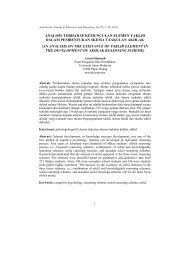
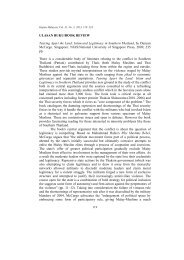

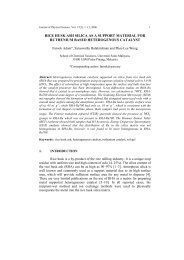

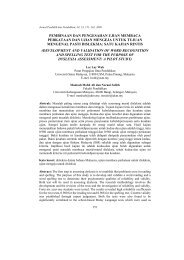
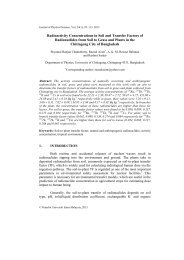
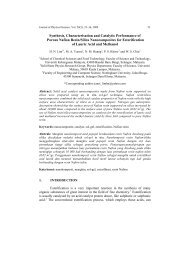

![KTT 111 – Inorganic Chemistry I [Kimia Takorganik I] - USM](https://img.yumpu.com/12405642/1/184x260/ktt-111-inorganic-chemistry-i-kimia-takorganik-i-usm.jpg?quality=85)
